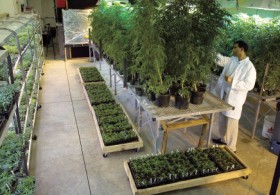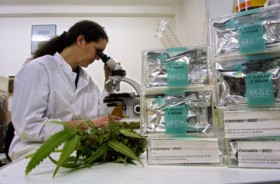 Part of Colorado’s new law allowing the recreational use of marijuana comes with new complications, especially for growers.
Part of Colorado’s new law allowing the recreational use of marijuana comes with new complications, especially for growers.
Under the new law, starting next January all marijuana products must be labeled according to their potency. The goal is to give consumers an idea of how much THC they’re getting in their products, similar to how alcohol makers must label the percentage by volume.
The labels are meant to inform buyers on the nature of what they are buying, and to help prevent those who are less experienced with marijuana from getting too high a “dose.”
However, growers are running into a problem: there are no standard test to determine how much THC is in a sample of marijuana. The tests that are available now are uncoordinated, and some owners of medical marijuana stores are rightly complaining that the same marijuana can receive different marks depending where it was tested.
This difference comes from varying methods of testing the marijuana, and laboratory owners advise growers not to compare the results from different labs. Currently, the margin of error for these tests can be as high as 25 percent.
In a new legal pot industry that is the first of its kind in the United States, these kinds of problems are to be expected. Colorado is not alone: Washington State is also grappling with how to implement the new regulations brought into law by voters. Both these states are in the fog as to how things will unfold, since marijuana is still prohibited by federal law.
Still, the two states can rely on existing medical marijuana laws as a foundation for creating new regulations. For entrepreneurs, these laws can’t come fast enough. Before anyone can apply for the necessary licenses to get into the business, the laws must first be in place.
 This is why labeling is becoming an issue: it can take around nine months to set up a lab that can reliably test and label samples of marijuana. Part of why it takes so long is because of a lack of academic or commercial research into the matter, which, of course, is a consequence of marijuana’s illegality under federal law. Labs that have permission from Big Brother to study cannabis aren’t allowed to work with samples from states that have legalized marijuana.
This is why labeling is becoming an issue: it can take around nine months to set up a lab that can reliably test and label samples of marijuana. Part of why it takes so long is because of a lack of academic or commercial research into the matter, which, of course, is a consequence of marijuana’s illegality under federal law. Labs that have permission from Big Brother to study cannabis aren’t allowed to work with samples from states that have legalized marijuana.
Without a standard for testing and labeling pot, labs must rely on their own systems and techniques for analyzing the marijuana, which has led to different labs coming up with different results.
Considering all this, it seems most of the problems stem from the fact that marijuana is still illegal under federal law. However, with the amount of money that stands to be made, it would be reasonable to believe these kinks will get hammered out quickly.









